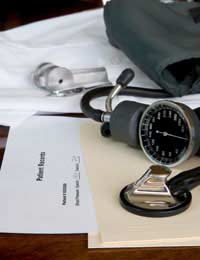Mitral Valve Stenosis

Sometimes called simply mitral stenosis this condition affects the mitral valve of the heart. This valve is located between the left atrium and left ventricle within the heart. In a healthy heart, when the atrium contracts the valve is opened and the blood flows through into the left ventricle.
What Exactly Is Mitral Stenosis?
In a heart affected by mitral stenosis, the valve becomes thickened and stiff and cannot open properly, which prevents the blood from flowing through the valve effectively.This thickening is called stenosis.Signs and Symptoms
As with other types of valve disease, the person may experience no symptoms whilst the disease is in its early stages. As it progresses, the person may feel tired, be breathless, experience heart palpitations, swelling of the ankles or even in some rare cases, chest pain. These symptoms may be worse on exertion and are caused because the heart is forced to work harder to try and pump the blood through the valve more effectively.Swelling may occur as fluid becomes able to accumulate around the lungs and limbs and some patients may also experience an increase in the amount of respiratory disorders such as chest infections as a result.Symptoms vary from patient to patient and may become worse as the disease develops.
Causes of Mitral Valve Stenosis
The most usual causes of mitral valve stenosis include suffering from rheumatic fever as a child or because of a congenital heart defect.Rheumatic fever can cause the components of the valve to become inflamed and thickened, or in some cases joined together as a result of infection. For those with congenital heart defects, the valve may have developed to be more narrowed than usual whilst in the foetal development stage in pregnancy.Specialists have also found that some medications can cause this condition, and some of the drugs used for migraines and Parkinsons have shown a link to the condition and should be prescribed with caution.
Treatment Options
Although not a cure for the condition, many medications can help to ease the symptoms and in some people this may be the only option. Taking water tablets can reduce fluid build up, and blood can be thinned using anti-coagulants helping the blood flow through the valve and also preventing clots from developing.For others, surgery may be an option. Balloon vavuloplasty may be required during which a small catheter is inserted in the heart and a balloon inflated opening and stretching the valve. This is a minimally accessed procedure using tiny wires and x-ray technology. For others heart surgery may be suggested and the valve either repaired or replaced using a prosthetic device depending on the overall condition of the valve.
Mitral valve stenosis can develop into a very serious condition with highly dangerous side-effects. It can develop without any obvious symptoms initially but they can develop very quickly and significantly affect the person’s quality of life.
Treatment options vary and surgery seems to be very effective in most cases. As soon as any symptoms are experienced seek advice from your GP to determine an accurate diagnosis or referral for tests.
- What is Ventricular Fibrillation?
- Stable and Unstable Angina: What's the Difference?
- What is Acute Coronary Syndrome (ACS)
- Why is High Blood Pressure Bad for the Heart?
- How Anorexia Affects the Heart
- What is Heart Failure?
- Preventing Cardiac Death in Young Athletes
- Are You at Risk of Heart Disease?
- An Enlarged Heart
- Hole in the Heart
- Pericarditis, Inflamation of the Pericardium
- Atherosclerosis, Hardening of the Arteries
- Heart Condition Dextrocardia Explained
- Why Do Palpitations Occur?
- Causes of Peripheral Artery Disease
- What is Atrial Myxoma?
- What is Cardiogenic Shock?
- Vitamin D & Heart Disease
- Wolffe-Parkinson-White Syndrome
- What Are Heart Murmurs?
- Rheumatic Heart Disease
- What is Myocardial Infarction?
- Aortic Stenosis Treatments Available
- What is Bundle Branch Block?
- Heart Valve Disease
- Explaining Heart Disease
- What is Supraventricular Tachycardia?
- Aneurysm Causes & Treatments
- Congenital Heart Disease Explained
- What is Pericarditis?
- Suffering From Endocarditis
- Palpitations Explained
- What is Heart Block?
- What is Atrial Fibrillation?
- Angina Symptoms & Treatment


Re: Laser Surgery for Coronary Artery Disease
I was diagnosed with Idiopathic Pulmonary Fibrosis (IPF) four years ago. For over two years, I relied on…
Re: Coronary Angioplasty Surgery
My husband had a stent put in at the beginning of January. It was done at a government hospital and the doctors appointment is…
Re: Hole in the Heart: What Happens Next?
I was just in hospital with left side pain and numbness was diagnosed with hole in heart I’m home now and I’m having…
Re: Hole in the Heart: What Happens Next?
Ok I'm 61 yes old.ive been in 3 motorcycle wrecks,I have sticky platelets I've been hospitalized 3:times with blood…
Re: Why Does My Heart Beat Faster After Sweet Food?
The coffee doesn't make a heart beat faster. Caffeine makes the hart beat harder/stronger. The sugar…
Re: Hole in the Heart: What Happens Next?
Hi Doctor, My friend is having 35 years and he is having a hole in the heart, he consulted many doctors in USA and…
Re: What is Heart Block?
Hello. I have born first degree heart block. 10 years ago was temporarily changing to 2 degrees, but stay first degree. Am I at high risk…
Re: Hole in the Heart: What Happens Next?
In Sept '16 I was diagnosed with hypertension (high blood pressure) and in May '17 I had a stroke - the only symptoms…
Re: Hole in the Heart: What Happens Next?
Hi Iam 53 years old and living very healthy life. I have blood pressure but it is in normal condition with proper…
Re: What is Heart Block?
Hi there I had a pacemaker fitted last year for Mobitz II heart block. My pacemaker is set to fire if my rate drops below 60 b/pm. Am I…